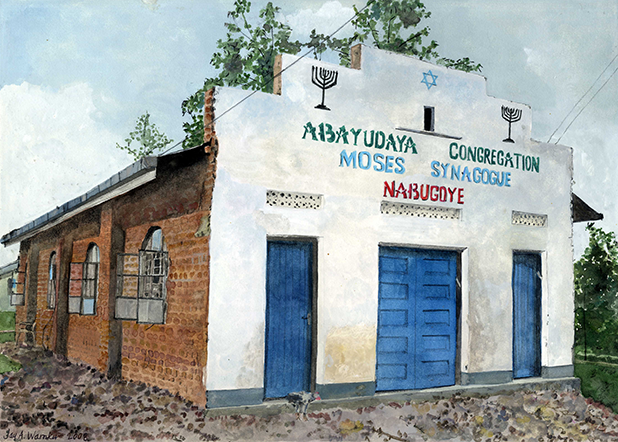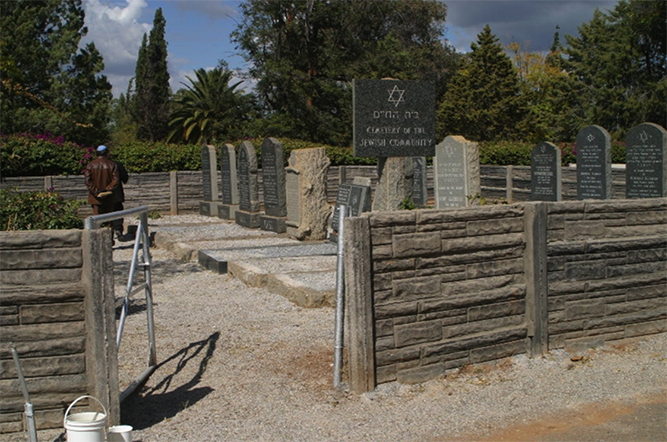 Exterior View (2008), 15” x 11” Watercolor, Jay A. Waronker
Exterior View (2008), 15” x 11” Watercolor, Jay A. Waronker
uganda
Moses Synagogue (Dating to the Late 20th Century) |
|

Interior View (2008), 11” x 15” Watercolor, Jay A. Waronker
|
Uganda is home to the Abayudaya (from the Lugandan word for “Jewish People” or “People of Judah”) community of Jews, a group made up of the large Bantu ethnic group native to Buganda, a subnational kingdom within the country. The black Abayudaya Jews live not at a single place in this region but in a string of unassuming and peaceful villages in the eastern part of Uganda near the border with Kenya. There a collection of modest synagogues building over fairly recent years can today be found. These Jewish houses of prayer are located to the east of Mbale, Uganda’s seventh largest city and the main municipal, administrative, and commercial center of Mbale District and the surrounding sub-region. Mbale, which can be reached by frequent buses from the capital city of Kampala, can serve as the best base for visiting the Abayudayan synagogues. Mbale’s city plan during British colonial times included a segregated European district, a middle area for Indians who have long live in Mbala, and a distinct native Africa section.
Christian and Muslim neighbors once looked on the Abayudaya with contempt, but inter-faith relations in recent times have improved, and some now view members of the Abayudaya with respect and admiration. Whereas the Abayudaya Jewish population was estimated at three hundred individuals at the time of the fall of Idi Amin in 1979, the community is said to now number up to two thousand people.
Besides the five synagogues located in the towns of Namutumba, Nasenyi, Putti, Namanyonyi, and Nabugoye, Abayudaya Jewish schools have been established in recent years with outside help from individuals and international Jewish organizations such as Kulanu. As the Abayudaya community has increased its interactions with outside Jews, mainly those from the United States and Israel, over the past dozen or so years, its religious ideology and customs has shifted towards more mainstream and normative Judaism. Members attend Shabbat services regularly following a conventional prayer book, maintain a kosher diet and slaughter their own animals in accordance with its regulations and, out of character from most Jews, remove their shoes before entering the synagogue in reverence to a practice by Jews in biblical times.
The largest and fanciest of the Abayudayan Jewish houses of prayer is the Moses Synagogue in the hill village of Nabugoye. Moses Synagogue is built on a flat site surrounded by other small structures, yet beyond are fine views of the countryside and mountains beyond. The synagogue is constructed out of locally-made rough bricks neatly veneered in buff-colored stucco at the front façade yet exposed on the sides and rear of the building. A corrugated metal gabled roof set on simple wood framing, ten actual glass window units with metal security grilles compared to other Abayudayan synagogues which only have openings in the walls, and two single and one pair of painted wood paneled doors leading into the sanctuary are architectural features of the structure. Above the doors are perforated bricks serving as vents. Along the north elevation is the ark niche, which projects out from the wall plane of the rest of the building. The front façade of the synagogue, which steps up towards the center, is hand-painted with the name of the congregation and two menorot (candelabras), providing clear indication that it is an Abayudayan Jewish house of prayer.
Located near the synagogue on a top-of-a-hill site offering nice views of the surrounding countryside and mountains beyond is a well-attended Jewish school (including some non-Jewish students) and its play area. Also as part of Nabugoye’s Jewish campus is a rudimentary guest house and Yeshiva (Jewish learning center) available to visitors for short or long stays.
 Exterior View (2005), 15” x 11” Watercolor, Jay A. Waronker
Exterior View (2005), 15” x 11” Watercolor, Jay A. Waronker
Moses Synagogue |
|
|
The synagogue in the small town of Nabugoye in easternmost Uganda was built by a congregation of Jews that numbered a couple of hundred at the time of this painting. The building, the largest and most finished of all synagogues in Uganda, is a one-room structure measuring 20’ x 50’. It contains an unpainted concrete floor, plaster walls painted white with a blue base, and simple wood roof framing exposed on the inside covered of the galvanized corrugated metal roof. The space is bigger than most other Abayudayan synagogues: 10’-8” high walls sloping up to 15’ along the roof ridge. Design features of the space include ten wood-framed arched windows with security bars, a rectangular panel made up of perforated brick vents above the window openings, and two single and one pair of painted wood doors along the southern side of the building. The space is filled several tubular aluminum and plaster chairs used by the men and women (who sit separately), several wooden bookshelves and cabinets lining the walls that are full of prayer and other books along with various synagogue supplies, a wood-framed bimah draped by a white cloth, fluorescent lighting fixtures hung from the exposed roof trusses, and an Ark with small wood paneled doors. The walls are mostly bare, although there are a few holiday liturgical and decorative flourishes particular to this synagogue, specifically an Abuyudayan community banner.
Weekly Friday night and Saturday morning Shabbat services are held here, and Monday and Thursday prayers are also conducted in the sanctuary whenever there is a minyan (quorum). The community has a small Sefer Torah, and local male members of the congregation lead the services.
